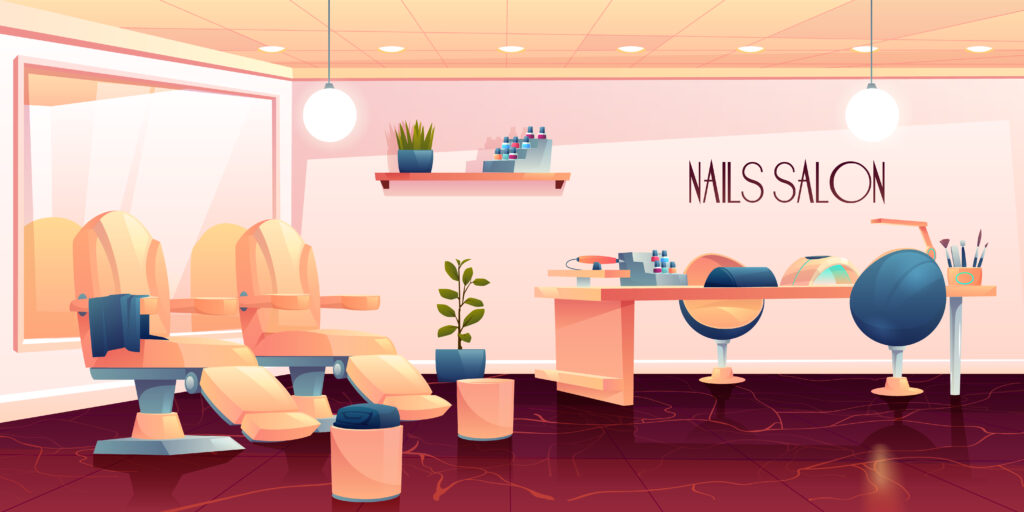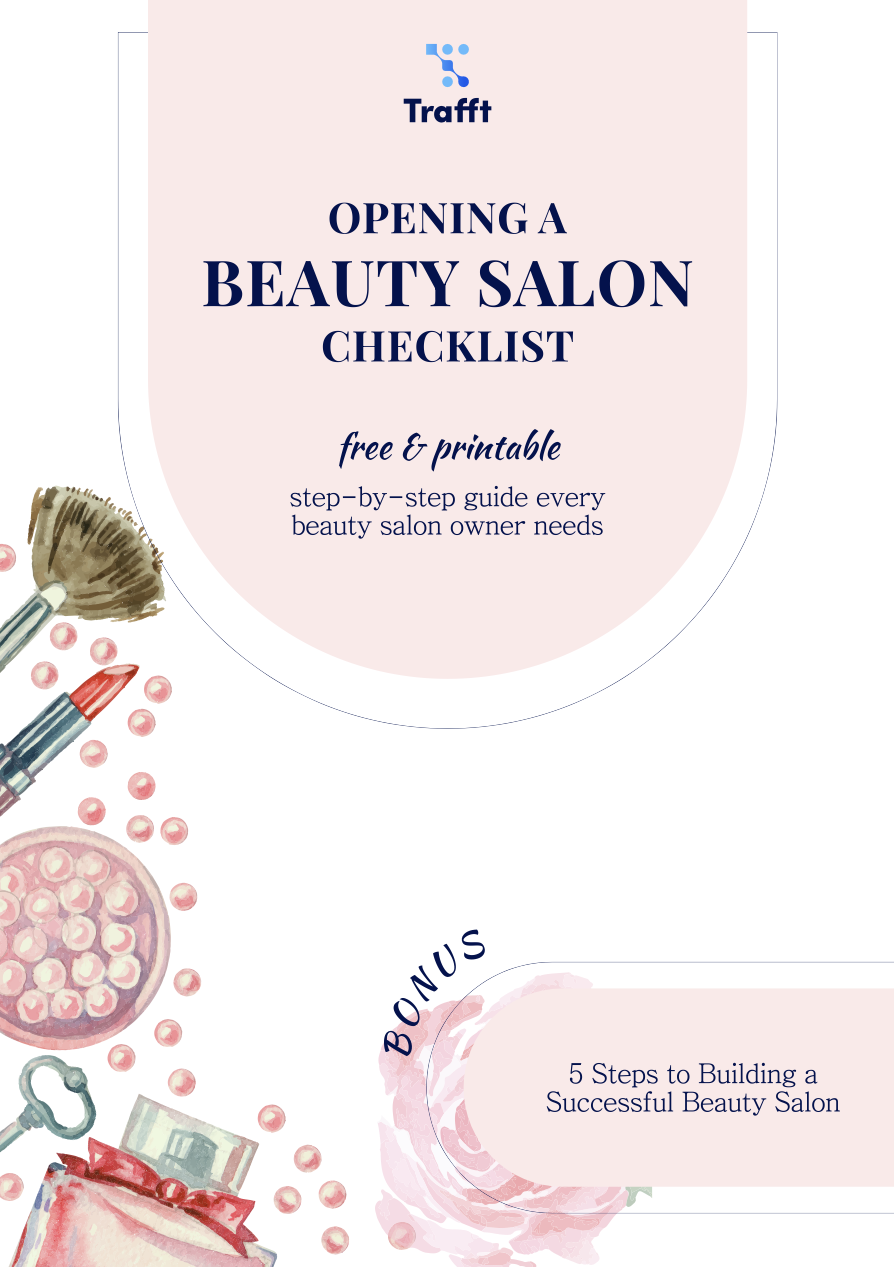Opening a salon has always been your dream? Well, with a little effort and planning, you can make it come true!
Starting your own salon is a promising business venture, but also an opportunity to foster creativity and personal connections in your community. If you love hair, nails, skincare, or any aspect of beauty, opening a salon can be a great way to share your skills and creativity.
We will guide you step-by-step through the journey of opening a salon. Keep reading and find out how to start a salon business!
How to Start a Salon Business
Thank you for subscribing. Check your mail for details
Research the market
Start by gathering information on the local beauty market. Research the demographic in your targeted area to understand potential customers’ age, gender, spending habits, and beauty preferences.
Tools like the U.S. Census data, market research reports from companies like IBISWorld, or even local government economic reports can provide valuable insights.
Once you’ve done analyzing the demographics, identify your direct and indirect competitors. Visit their websites, review their services, pricing structures, marketing tactics, and customer reviews. Use platforms like Yelp, Google Reviews, and Facebook to understand their strengths and weaknesses. Tools like SWOT (Strengths, Weaknesses, Opportunities, Threats) analysis can be particularly useful here.
After your research, think about what makes your salon stand out. Whether it’s unique services, superior customer service, a niche market like natural beauty products - this is your unique selling proposition. It makes you stand out, and attract new clients.
Write a salon business plan
Opening a salon requires a well-structured business plan to guide you as a salon owner, but it also helps you communicate your vision to potential investors, partners, and employees.
This plan acts as a blueprint of your business, with details about every crucial aspect from initial goals to operational strategies and financial forecasts.
What to include in your salon business plan
- Mission and vision statements: Clearly articulate why your salon exists and what you hope to achieve. Your salon mission statement should reflect your core values and the unique experience you intend to offer.
- Service offerings: Describe the range of services your salon will provide. This could include hair cutting, coloring, styling, and other beauty treatments. Detail any unique services or specialties that set your salon apart from competitors.
- Operational plan: Outline the day-to-day operations of your salon. This includes your location, equipment needs, hours of operation, and staffing requirements. Specify roles and responsibilities for your team to ensure smooth operations.
- Market analysis: Provide an in-depth analysis of your target market and industry trends. Identify your primary customer segments and discuss how your salon will meet their specific needs. Also, analyze your competitors to highlight what distinguishes your salon from others in the market.
- Marketing strategy: Develop a detailed salon marketing strategy that outlines how you will attract and retain customers. This should include both online and offline marketing ideas, such as social media advertising, local partnerships, promotional events, and loyalty programs.
- Financial plan: Detail your funding requirements, startup costs, ongoing expenses, and revenue projections. This section should include a pricing strategy for your services, projected profit and loss statements, cash flow forecasts, and a break-even analysis. A well-prepared financial plan is crucial for securing funding from investors or banks.
- Executive summary: While this section is typically written last, it appears first in your business plan. It should summarize the key points of your plan, including your business model, key financial highlights, and what sets your salon apart from the competition.
Don’t forget to check out our comprehensive guide on how to create a successful salon business plan!
Choose the right business structure

Image by rawpixel.com on Freepik
When planning how to open a salon business, choosing the right business structure is an important decision that impacts your liability, taxation, and ability to grow.
Here are a few common types of business structures:
- Sole Proprietorship: This is the simplest form of business structure, best for small, low-risk businesses. The owner is personally liable for all debts and actions of the business.
- Partnership: This involves two or more people who agree to share in the profits or losses of a business. A partnership is relatively simple to establish and operates similarly to a sole proprietorship in terms of personal liability.
- Limited Liability Company (LLC): Combining the benefits of both partnership and corporation, an LLC protects owners from personal liability in most instances, and profits and losses can be passed through to owners without taxation of the business itself.
- Corporation (C or S): A corporation is a legal entity separate from its owners, providing the highest level of personal liability protection. It's more complex and expensive to set up and operate. An S corporation allows profits, and some losses, to be passed through directly to owners’ personal income without ever being subject to corporate tax rates.
For opening a salon, forming an LLC is advisable - it offers liability protection. This is important due to the nature of the beauty industry where treatments could potentially lead to customer claims. An LLC also provides flexibility in management and taxation benefits.
Obtain necessary licenses and permits
Opening a salon means obtaining the necessary licenses to ensure safety, compliance, and credibility. You want to make sure your clients know they’re in good hands, so make sure you obtain the following licenses:
- Business License: Most locations require this basic license to legally run your salon.
- Cosmetology License: Every stylist or beautician must have this license to provide beauty services. It usually involves completing training hours at a certified school and passing a state exam.
- Salon License: Besides individual licenses for stylists, some states require a salon license. This might involve an inspection to check that your salon meets health and safety standards.
- Health Department Permit: This permit might be needed to make sure your salon meets health standards, especially since you'll be using chemicals and performing treatments that could impact health.
- Employer Identification Number (EIN): Get EIN number from the IRS if you’re going to have employees. It’s needed for tax purposes.
- Certificate of Occupancy: This certificate shows that your salon building complies with local building codes, zoning laws, and regulations.
Identify recurring expenses and operational costs

Apart from the initial costs, you’ll also need to consider recurring and operational costs. These can include:
- Rent or mortgage payments (if you own the property)
- Utility bills (electricity, water, heating)
- Salaries for stylists and other staff members
- Costs of salon software and salon booking apps, etc.
- Replenishing products
- Business insurance, salon insurance, and commercial property insurance
- Licensing fees (cosmetology license, business license)
A detailed list of your recurring expenses can provide a clearer picture of your salon’s financial health, ensuring you’re prepared for the long haul. Don’t forget to set break-even points so you have a clear goal of expected revenue.
Explore viable financing options
With a good understanding of your associated costs, you now know how much money is needed as a startup. Do you have savings to finance the opening? If not, you can now explore viable financing options. These might include:
Personal savings. It's ideal to have saved funds to finance a salon opening. Perhaps you have stocks, properties, cars, or other things that you can sell.
Loans from family or friends. Supportive family and friends might be ready to help you out in starting a salon business. If this is the case, you will avoid the headaches of dealing with a bank or worrying about your credit score.
Small business loans. Although a bank loan might look like the easy choice to finance your plan to open a salon, it is not as easy to get. You will need a solid bank credit score. If you are starting out and don’t have the track record to show, a bank loan will be tricky to get.
SBA Financing. The Small Business Administration (SBA) offers affordable loans for starting businesses like salons. These loans can cover costs like equipment and renovations. By backing part of the loan, the SBA makes it safer for lenders, easing the path for small businesses to secure needed funds.
Partnership. It can be a great way to fund the opening of a salon business. In a partnership, two or more individuals agree to contribute resources, skills, or time to a business with the expectation of sharing profits and losses.
Design your salon space
An attractive and welcoming space is very important when starting a salon. You want your clients to feel comfortable, cozy, and cared for from the moment they step inside. To achieve the perfect salon design, think of these:
Determine the ideal size and layout
- Service Areas: Allocate space for hair styling, washing stations, and rooms for additional services like facials or massages.
- Reception Area: Make the first point of contact inviting with a comfortable seating area and a reception desk.
- Storage Space: Ensure you have enough room to store products and equipment neatly.
- Break Room: Provide a space for staff to relax and recharge.
Check out what the average salon dimensions you should aim for are.

Image by vectorpouch on Freepik
Choose a theme that reflects your brand
Your salon's design and theme should match the brand image you want to project, whether it’s luxurious, modern, cozy, or eclectic. This affects the overall feel of the salon and can influence client perception.
Select the right furniture and decor
Balance between essential purchases and desirable items. Start with basic needs like chairs, stations, and reception desks.
Keep in mind that while key furniture pieces don't need to break the bank, strategically chosen decor and smaller items can significantly elevate the appearance of your salon. Whether you're aiming for a luxurious or modern vibe, the right accents can create an upscale feel without a hefty price tag.
Don’t forget about online and offline marketing
Online marketing such as social media marketing and a website are a go-to way to let potential customers know about your business. Online platforms allow you to reach customers, showcase your services, and build a brand identity. Additionally, running online salon ads can drastically boost your marketing efforts. Check out some creative salon ads to inspire you!
Post engaging content, before and after photos, offer promotions and interact with followers. These can help you develop a loyal customer base and keep your salon top-of-mind for both current and future customers.
Offline marketing still remains a powerful tool for attracting local clientele. Distributing flyers, posting banners, and offering promotional deals through local newspapers or community bulletin boards can effectively draw attention.
Let salon scheduling software help you

Imagine managing your salon effortlessly, with a simple click. That's what Trafft salon scheduling software brings to the table.
Transform your daily operations with features built to streamline your business!
Scheduling? Easy.
Staff management? Handled.
Client communications? Flawless.
This is the all-in-one salon management solution that you’ve been waiting for!
You don’t want to waste your time on appointment booking? Trafft's dedicated booking page changes the game. It's as easy as tapping your screen. Your clients pick a time. You confirm. That's it. No more back-and-forth calls, just smooth sailing.
And don’t forget your clients! Need to send appointment reminders or promotional messages? Trafft's SMS and email reminders make it a breeze. Engage with clients like never before. Happy clients, booming business!
What about keeping track of your staff? Trafft’s efficient staff management ensures everyone's on the same page. Assign tasks, manage shifts, and monitor performance. Less hassle, more productivity!
But the real magic of Trafft? It’s more than just software. It’s a dedicated business partner that’s got your back 24/7. With our outstanding customer support, you're never alone on your journey to success.
Ready to make the best decision for your business? Start your free trial NOW!
Final Thoughts on How to Open a Salon
Opening a salon is an exciting venture that involves detailed planning and strategic execution.
While the journey may seem daunting, the rewards of seeing your salon brand flourishing are unparalleled.
Embarking on this journey takes courage, passion, and perseverance. However, with careful planning and determination, you’ll be well-equipped to open your own salon and make your mark in the booming beauty industry!
FAQ on Opening a Salon
What's the first step in opening a salon?
Right off the bat, the first thing to do is put together a comprehensive business plan.
You'll need to outline the services you'll offer, identify your target audience, and estimate your startup and operating costs. This helps create a roadmap for your business and can be crucial when seeking financing.
How much money do I need to start a salon?
The initial investment can vary widely based on your location, the size of the salon, and the services you'll offer. On average, it can range from $75,000 to $200,000.
This includes costs for leasehold improvements, equipment, inventory, marketing, and initial operating expenses.
Do I need a license to open a salon?
Yes, absolutely! It's essential to obtain a salon license, and any person performing services in your salon may need individual licensure as well.
The exact requirements can vary by region, so make sure to check local regulations.
How can I find the right location for my salon?
When looking for a prime spot, consider foot traffic, parking availability, visibility, and the proximity to complementary businesses.
It's also essential to think about your target market - is this a location they would frequent?
What equipment will I need for my salon?
You'll need salon chairs, hair washing stations, styling tools, and a reception desk at a minimum. Also, consider other equipment for services you plan to offer such as manicure tables or spa equipment.
Don't forget about retail display fixtures for any products you'll sell!
How do I attract clients to my new salon?
Your marketing strategy is key here. Online advertising, social media engagement, and direct mail can be effective.
Special promotions for new clients or referral incentives can also help. Plus, never underestimate the power of word-of-mouth - encourage happy clients to spread the word!







